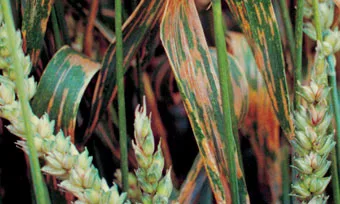
Septoria tritici in wheat
Septoria tritici in wheat
What is Septoria tritici?
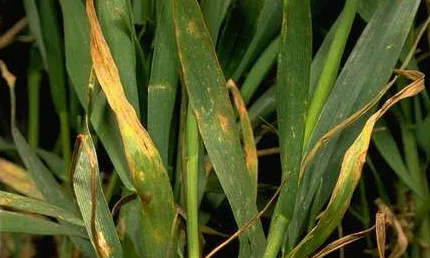
Early season infection
The ideal growth conditions for Septoria are temperatures of between 15-25°C and free water or high humidity - wet springs and summers are ideal. It spreads through vertical and horizontal splash dispersal, or through air-borne ascospores (long range dispersal).
The usual lifecycle for Septoria is 15-18 days, although it can remain in the latent phase for up to 28 days, with no visible symptoms. Lesions are first evident on crops in the autumn.
The disease overwinters as dormant mycelium, pycnidia, and pseudothecia on infected wheat straw debris, grass hosts, volunteers and autumn-sown crops.
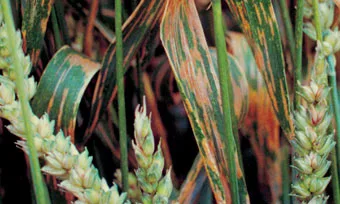
Later season infection
How does Septoria tritici impact wheat yields?
Yield penalties from Septoria tritici in wheat can range from 30% to as high as 50% in high pressure areas and seasons. These penalties result from a reduction in photosynthetic capability of primarily the upper three leaf layers from infection throughout the season. Every 1% disease on the flag leaf incurs a 1% yield penalty or 0.6% yield penalty on leaf 2. Infections can be exaggerated by the presence of yellow or brown rust.
How to recognise Septoria tritici symptoms
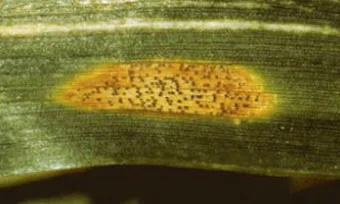
Close-up of typical lesion with black pycndidia
Symptoms are pale brown to greenish-grey oval or ‘stripe’ lesions, with black pycnidia visible in the lines as shown above. A single lesion can originate from just one spore. In ideal conditions with multiple infection sites, lesions will join up to cover large areas of the leaf.
Visible symptoms only become apparent towards the end of the life cycle, and the other 80% is largely asymptomatic. Leaves can appear green and healthy during the long latent phase of the disease, where the fungus grows in between the leaf cells without damaging them. Once latent mycelium becomes established, the switch to visible lesions can occur in a matter of days.
Comparison of pairs of uninfected (left) and infected (right) wheat leaves
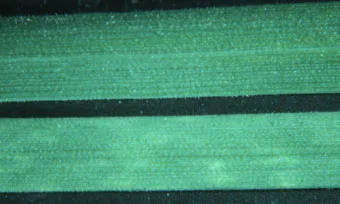
Advanced latent infections after 10 days, showing barely evident yellowing
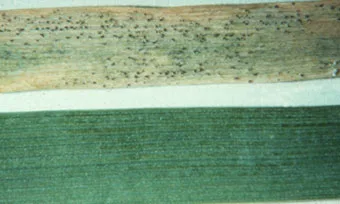
Visible symptom expression just 5 days later, indicating full extent of infection
How to control Septoria tritici
Focus your foliar disease control programme on Septoria tritici and build in additive contingency plans for less predictable and patchily-dispersed foliar diseases such as rusts and mildew where required.
Programmes designed for optimised Septoria control are about effective risk management. Growing less susceptible varieties and later drilling can significantly reduce the risk of having high Septoria pressure. Whilst varietal resistance is an important part of an integrated Septoria management strategy, it only incurs partial resistance, so even the least susceptible varieties need to be used in conjunction with a robust fungicide programme.
Robust fungicide programmes using the best available chemistry are cost-effective, offering significant return on investment. Avoid ‘borderline’ dose rates of Septoria fungicides, as these can end up being more costly should following sprays not be well-timed, or if weather patterns or poor spray choices unexpectedly enhance disease pressure.
Septoria control should be viewed as an additive sequence to give maximum protection of the upper canopy, starting with a T0 where appropriate in higher risk scenarios and following up with either Aviator 235 Xpro or Ascra Xpro at T1.
Where the T1 spray can be perfectly timed and Septoria pressure is low, use Aviator 235 Xpro. In a moderate to high Septoria pressure situation or where you’re not confident of hitting the correct timing, use Ascra Xpro at 1.0 to 1.2L/ha tailoring to risk and disease pressure.
For T2, use AscraXpro at 1.2 L/ha where the T2 can be well-timed and disease pressure is moderate. In higher pressure situations or where the spray cannot be well timed and more curative activity may be required, use AscraXpro at 1.5 L/ha.
Ascra has been proven to provide excellent Septoria control, resulting in increased yields. In high disease pressure situations or where applications have been delayed significantly, increase to the full rate of 1.5 L/ha to maximize eradicant activity. In lower pressure situations AscraXpro used at 1.2 L/ha will give excellent cost-effective disease control.


